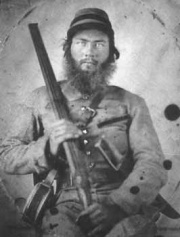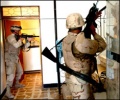Combat shotgun
A combat shotgun is a shotgun that is intended for use in a combat role. The earliest shotguns specifically designed for combat were the trench guns or trench shotguns issued in World War I. While limited in range, the multiple projectiles typically used in a shotgun shell provide increased hit probability unmatched by other small arms.[1]
Contents |
[edit] History
While the sporting shotgun traces its ancestry back to the fowling piece, which was a refinement of the smoothbore musket, the combat shotgun bears more kinship to the shorter blunderbuss. Invented in the 16th century by the Germans, the blunderbuss was used through the 18th century in warfare by British, Austrian, and Prussian regiments, as well as in the American colonies. As use of the blunderbuss declined the United States military began to load buck and ball, and fowling pieces were commonly used by militias, such as during the Texas Revolution, and buck and ball loads were used by both sides of the American Civil War, often by cavalry units.[2][1]
While shotguns were used by US Marines in the Philippines insurrections and by General "Black Jack" Pershing's pursuit of Pancho Villa, the modern concept of the combat shotgun was fully developed by the American Expeditionary Forces during World War I. The trench gun, as it was called, was a pump action shotgun loaded with six rounds containing antimony hardened 00 buckshot. The shotguns proved effective enough to elicit a diplomatic protest from the German government, claiming the shotguns caused excessive injury, and that any troops found in possession of them would be subject to execution. The US Government rejected the claims, and threatened reprisals in kind if any US troops were executed for possession of a shotgun. There is no evidence that the Germans carried out their threat, and that was the only challenge to the military legality of the shotgun.
The shotgun was also well suited for house-to-house fighting. An example of this effectiveness is an event from September 27, 1918. Sergeant Fred Lloyd, armed with a Winchester Model 1897 trench gun, single-handedly retook a German-held French village, routing 30 German soldiers.[3]
The shotgun was used by Allied forces and Allied supported partisans in all theaters of combat in World War II, and both pump and semi-automatic shotguns are currently issued to all branches of the US military; they have also been used in subsequent conflicts by French, British, Australian, and New Zealand forces, as well as many guerrillas and insurgents throughout sub-Saharan Africa, Latin and South America, and Southeast Asia.[1] Six different model of shotgun was accepted in the U.S army during World War II, the most popular being the M97 and M1912.
Gen Douglas MacArthur attempted to restrict the use of shotgun even though the shotgun has proven its worth amongst the marines in the Pacific war during close combat in the trench and jungle fighting. General Alexander Patch was seen being armed with an Winchester shotgun when he personally lead an attack in Guadalcanal.[4]
During the recent Somalian conflict in 1992, the U.S task forces tested out a new type of shotgun called KAC Masterkey for their standard service rifle during Operation Gothic Serpent. According to the Army Rangers, their verdict were positive for this new type of breaching gun.
In the current event of post-war Iraq, the U.S forces are using their official combat shotguns to clear out suspected insurgent hideouts in house to house fighting.[5] One notable experimental shotgun used in limited number during Operation Enduring Freedom was XM26 for breaching door or QBC.
[edit] Characteristics
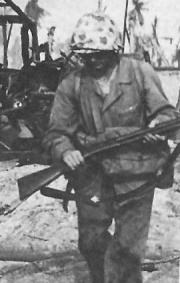
The most common type of shotgun used for this purpose is the manually-operated, slide-action/pump-action type, because it is commonly believed to be less prone to malfunction (particularly when dirty) than semi-automatic designs.
Combat shotguns typically have much shorter barrels than shotguns for hunting and usually, though not always, have magazines of modified design to hold more than the three to five shots normal with sporting or hunting shotguns. Most combat shotguns have tubular magazines to hold the cartridges, mounted underneath the barrel, identical to those of hunting shotguns except for being longer to hold more ammunition, though some recent designs have detachable box magazines.
Combat shotguns for military are typically very similar to the police riot shotgun, but the military versions will usually have a ventilated steel or plastic hand guard over the barrel to reduce the danger that a soldier will burn his hand on the hot barrel during repetitive rapid fire, and usually also have attachment hardware to mount a bayonet under the muzzle. Riot shotguns are also more likely to trade off the increased magazine capacity for the decreased size that entails; for example, a combat model would be more likely to have a 51 cm (20 inch) barrel and a 7 to 10 shot capacity, while riot shotguns are often found with barrels of 35 to 46 cm (14 to 18 inches) and a capacity of 5 or 6 rounds.
[edit] Combat use
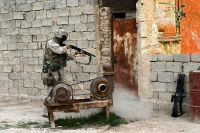
- Offensive weapon
- Breaching system
- Less lethal crowd control
Effective range of the shotgun with standard buckshot is limited to about 30 meters with a full stock (depending on the sights on the gun), and 10 when equipped only with a pistol grip due to the difficulty in accurately aiming without a full stock. Slug rounds, if available, can extend the effective range of the shotgun to 100 meters (although this is also dependent on the shotgun's sighting system; right sights and ghost ring sights will allow the average shooter to effectively engage human-sized targets at considerably greater distances than with a bead sight).
Less lethal rounds vary, with ranges from 10 meters for rubber buckshot to 75 meters for rubber slugs. These less lethal munitions are the same type as used by police, and have served well in riot control situations, such as that in Kosovo in 2001.[6]
When used in as a door breaching system, the shotgun may be provided with a muzzle extension to allow it to be pressed firmly against the door while providing the correct standoff distance for optimum performance. While there are specialized rounds for breaching doors with minimal hazard to any occupants of the room, any type of round will do the job, though with some degradation of effectiveness and increased risk of collateral damage. In operations in Iraq, the shotgun was the preferred method of door breaching by infantry units, ideally with a frangible breaching slug. For the breaching role, shorter barrels are preferred, as they are more easily handled in tight quarters.
The limited ammunition capacity is one of the primary downsides of the combat shotgun. While box magazines are available in some models (such as shotgun derivatives of the AK-47 design, like the Saiga-12), the tubular magazine is still dominant. This limits capacities; the current US pump shotgun issued, the Mossberg 590A1, has a 5 or 8 shot capacity depending on barrel length. However, the tubular magazine does allow easy "topping off" (a tube-fed pump shotgun can be kept shouldered and aimed at a target and ready to fire while being loaded), so training emphasizes the need to load the magazine to full capacity whenever the opportunity presents itself. A common doctrine is "shoot one, load one": load a shell immediately after every shot (when this does not jeopardize the operator's safety), to ensure that the shotgun is fully loaded at all times; this ensures that the operator has a full magazine at his/her disposal in case of emergencies when he/she may not be able to reload in between shots.[7] A pistol is also advised as a backup weapon, should the operator empty the magazine and not have time to reload. A sling to carry the shotgun is essential if it is to be used in conjunction with another weapon, so that the shotgun may be readily accessible.[8]
[edit] Effectiveness
A Joint Service Combat Shotgun Program report on the lethality of shotguns in war states, in support of the use of the shotgun in warfare, "the probability of hitting a man-sized target with a shotgun was superior to that of all other weapons", and goes on to support this with statistics compiled by the British from the conflict in Borneo in the 1960s[1].
The buckshot typically used in a combat shotgun spreads out to a greater or lesser degree depending on the barrel choke, and can be effective at ranges as far as 70 m (75 yards). The delivery of the large number of projectiles simultaneously makes the shotgun the most effective short range weapon commonly used, with a hit probability 45% greater than a submachine gun, and twice as great as an assault rifle[1]. While each pellet is only as effective as a small caliber handgun, and offers very poor penetration against an armored target, the multiple projectiles increases the likelihood of one or more peripheral wounds.
| Load | Hits @ 50 yd (46 m) | Hits @ 75 yd (68 m) |
|---|---|---|
| 34 pellet #4 buck | 6 | 2 |
| 27 pellet #4 buck | 10 | 3 |
| 20 pellet #1 buck | 7 | 4 |
| 16 pellet #1 buck | 6 | 2 |
| 12 pellet 00 buck | 4 | 2 |
| 9 pellet 00 buck | 3 | 1 |
| 8 pellet 000 buck | 1 | 0 |
A number of compromises are involved in choosing a shot size:[7][9]
- Smaller pellets lose velocity more rapidly and penetrate the target less
- Larger pellets means fewer pellets, resulting in a reduced probability of hits
- Heavier loads produce more recoil and less velocity than lighter loads
- Reduced recoil loads (less shot and/or lower velocity) may produce smaller patterns, which may increase hit probability
[edit] Ammunition
The most common type of ammunition used in combat shotguns, whether for military or law enforcement purposes, is buckshot, typically a 70 mm (2 3/4 inch) 12 gauge shell loaded with 9 hardened 00 buckshot, with a diameter of about 8.4 mm (.33 inch). Buckshot is brutally effective at close ranges against unarmored targets--enough so that Germany issued a protest against its use in 1918[1]. The only other type of ammunition currently in use in military shotguns are breaching rounds, which are specially designed frangible rounds designed to destroy a door lock or hinge while minimizing the risk of damage to occupants of the room. Shotgun slugs are currently under consideration by the US military as an anti-material round; the tendency of typical commercial shotgun slugs to deform on impact would render them illegal under the Hague Convention of 1899.
In military use, flechette ammunition has also been used in shotguns (primarily by special forces, such as its use by the SEALs in the Vietnam War),[10] but this is not common. Other experimental shotgun ammunition has been created, such as SCIMTR, but none have been successful enough to be adopted.
Due to the great flexibility of the shotgun, it is often used in non-offensive roles as well. The US Infantry, for example, offers a number of less lethal varieties of ammunition for use in the riot control role, and for door breaching with #9 birdshot, shotgun slugs, and specialized breaching rounds. Less-Lethal options also include the use of grenade launching cups, special launching cartridges and a less-lethal grenade.
There are a number of experimental rounds currently under development and consideration by the US military, including explosive rounds and stand-off breaching rounds, that could further improve the range and flexibility of the combat shotgun.
[edit] Method of operation
There are two primary modes of operation for combat shotguns, the pump action, and various semi-automatic designs, usually gas operated. The SPAS-12, SPAS-15, and Benelli M3[11] shotguns, combine the two, offering pump action or, when the pump is locked forwards, gas operation. There have also been a few fully automatic shotguns produced.
The autoloading shotgun (semi or full automatic) offers a higher (theoretical) rate of fire than a pump shotgun, though controlling a heavy recoiling shotgun in rapid fire is difficult. The autoloading action is more suitable for firing from a prone position, as operation of a pump action moves the elbow normally used to support the shotgun, and it can more effectively be used one-handed, unlike pump actions which require two hands for effective cycling of the action.
The pump shotgun is more versatile than the semiautomatic, as it will more readily fire low powered less than lethal munitions which lack sufficient pressure to cycle the action in an autoloading design. A pump shotgun, which does not rely on its ammunition for energy to cycle, operates normally with the lower powered ammunition, and provides utility in combat and riot control situations. In addition, the pump shotgun has an advantage in situations such as door breaching, where the shotgun is immediately dropped (retained by a sling) and replaced by another weapon after the door has been breached. By not cycling the action after firing the final breaching rounds (multiple rounds are often required) the pump shotgun is left without a loaded round in the chamber, unlike a semiautomatic shotgun.
[edit] Use in asymmetric warfare
Due to the widespread use of the shotgun as a sporting firearm, its used in guerilla warfare and other forms of asymmetric warfare. Che Guevara, in his 1961 book Guerrilla Warfare, notes that shotgun ammunition can be obtained by guerrillas even in times of war, and that shotguns loaded with heavy shot are highly effective against unarmored troop transport vehicles. He recommends that suburban guerrilla bands should be armed with easily concealable weapons, such as handguns and a sawed-off shotgun or carbine. Guevara also mentions an improvised weapon developed by guerrillas consisting of a sawed-off 16 gauge shotgun provided with a bipod to hold the barrel at a 45 degree angle. Called the "M-16", this was loaded with a blank cartridge formed by removing the shot from a standard shotshell. A wooden rod was then placed in the barrel, with a Molotov cocktail attached to the front. This formed an improvised mortar capable of firing the incendiary device accurately out to a range of 100 meters.[12]
[edit] See also
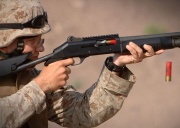
- Winchester Model 1897 12 gauge pump-action exposed-hammer shotgun used from WW I through Korean War
- Winchester Model 1912 12 gauge pump-action hammerless shotgun used from WW I through Vietnam
- Ithaca 37 12 gauge pump-action shotgun used by U.S. Navy SEALS in Vietnam with duckbill attachment
- Remington 870 pump-action combat shotgun used by the United States Air Force for air base/aircraft defense
- Mossberg 500 pump-action combat shotgun used by the United States Army and Marines
- Benelli M1014, a gas actuated semi-automatic which is the current "Joint Service Combat Shotgun", serving as a replacement for pump action models
- Franchi SPAS-15, a 12 gauge shotgun with switchable pump-action/semi-automatic firing modes
A group of US Marines in Iraq in 2005, armed with a combat shotgun, assault rifle, and squad automatic weapon.
[edit] References
- ↑ 1.0 1.1 1.2 1.3 1.4 1.5 Joint Service Combat Shotgun Program, includes the history of the shotgun in combat, and the requirements of the Joint Service Combat Shotgun
- ↑ See main article, shotgun.
- ↑ Bo Barbour (April 2003). "The evolution of the army combat shotgun". Military Police.
- ↑ http://www.amazon.com/gp/reader/1855329956/ref=sib_dp_pt/002-7066355-9070454#reader-link Osprey Men-At-Arms 342 page 24
- ↑ http://findarticles.com/p/articles/mi_m0IAV/is_6_93/ai_n16346115
- ↑ Shotguns at GlobalSecurity.org
- ↑ 7.0 7.1 7.2 Some Thoughts on the Combat Shotgun; John Schaefer
- ↑ The combat shotgun in the BCT Infantry Magazine Sep 1 2006 Robert D. Clements
- ↑ |title=The Box O' Truth #20 - Buckshot Patterns
- ↑ Historical Center’s Firearm Collection Spans 200 Years
- ↑ Benelli - Firearms - Special Purpose
- ↑ Guerrilla Warfare Ernesto "Che" Guevara 1961
- "Give Us More Shotguns!" by Bruce N. Canfield, American Rifleman, May 2004
- Fawcett, Bill. Hunters & Shooters, An Oral History of the U.S. Navy SEALS in Vietnam. NY: Avon Books, 1995. ISBN 0-380-72166-X, pp. 79-80, especially.
- The Magnificent Mossberg, Guns & Ammo Magazine, April, 2007
- The evolution of the army combat shotgun Military Police article by Bo Barbour

